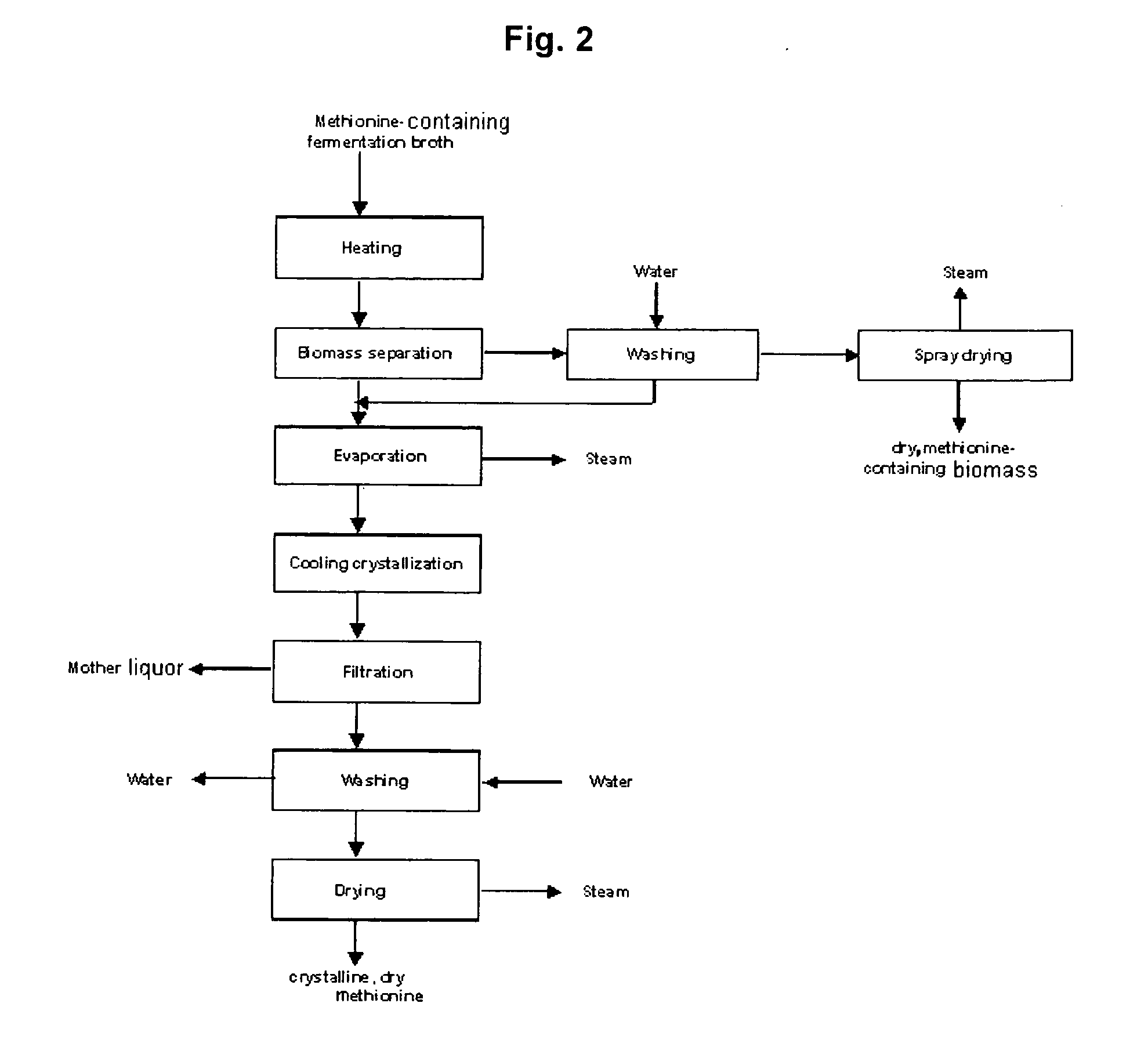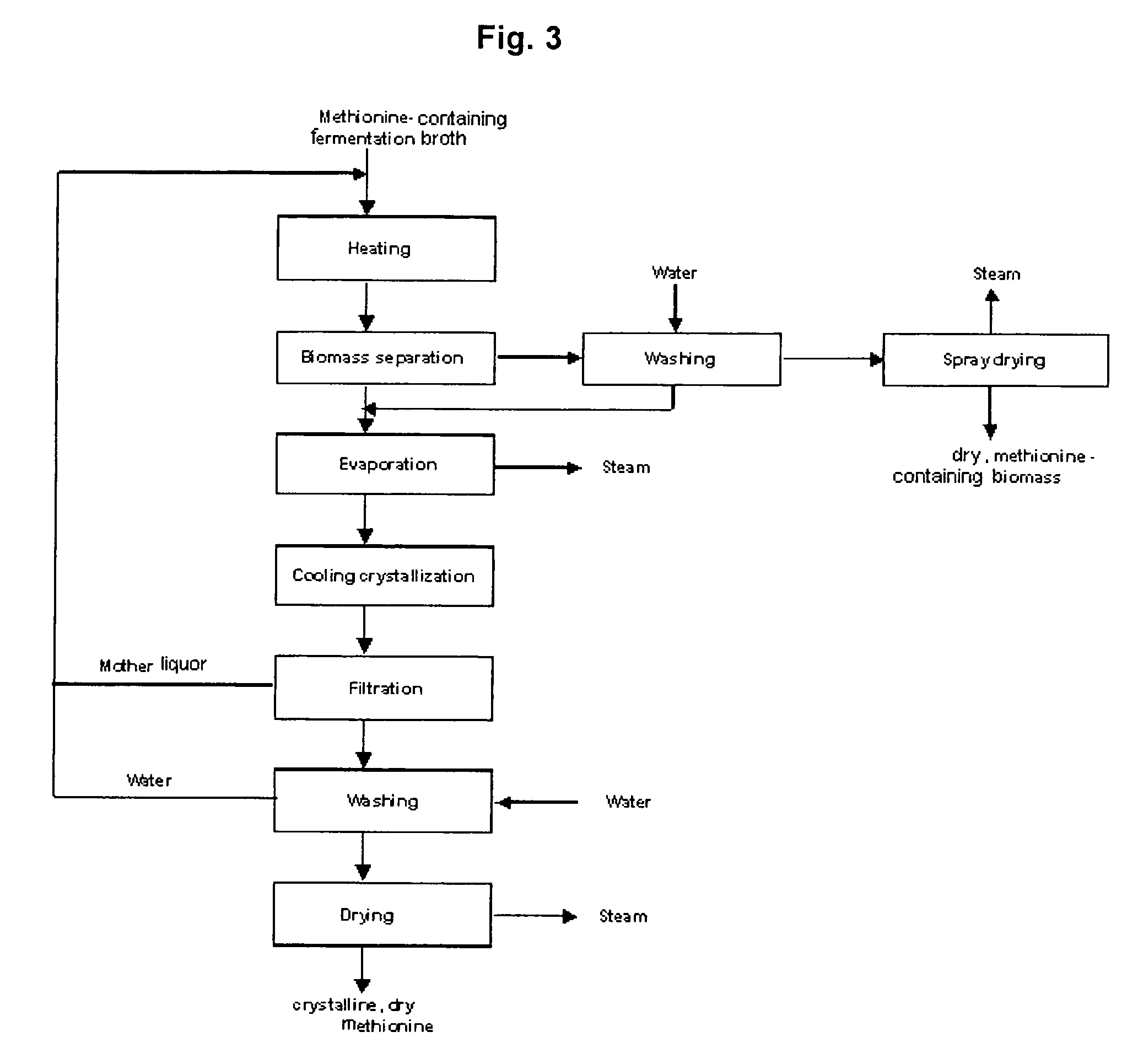Method for the production of methionine
a methionine and microbial technology, applied in the field of methionine production methods, can solve the problems of large waste streams, difficult purification, and processes which have been described to date for the production of methionine on an industrial scal
- Summary
- Abstract
- Description
- Claims
- Application Information
AI Technical Summary
Benefits of technology
Problems solved by technology
Method used
Image
Examples
example 1
a) Production of Methionine by Fermentation
[0185] To produce a representative fermentation broth for the purification of methionine, a laboratory fermentation was carried out. The Corynebacterium glutamicum strain ATCC13032 (American Type Culture Collection, Manassas, USA) was grown in a preliminary culture of 200 ml of BHI medium (Difco / Becton Dickinson Franklin Lakes, USA). In the Techfors fermenter, the preliminary culture was then inoculated into the culture medium (approximately 14 l).
[0186] The fermentation medium of the main culture had the following composition [0187] 2 g / l of KH2PO4 [0188] 2 g / l of K2HPO4 [0189] 10 g / l of ammonium sulfate [0190] 100 g / l of glucose [0191] 5 g / l of yeast extract [0192] 20 mg / l of kanamycin [0193] 1 g / l of KS911 ASM antifoam [0194] pH 7.0
made up with demineralized water to the desired final volume
[0195] Trace salt solution 1 ml / l of medium
FeSO4•7 H2O 10 g / lMnSO4•4-6 H2O 10 g / lZnSO4 2 g / lMgSO4•7 H2O250 g / lAdjust to pH 1 using HCl
[0196] ...
example 2
[0206] Starting from the same starting material, the process is modified to the extent that the biomass is separated off by means of centrifugation and the biomass which is separated off is then washed with 5 l of water (FIG. 2). After centrifugation, the resulting supernatant is added to the supernatant of the first biomass separation. The entire supernatant is concentrated to a methionine content of 16% at 100° C. and atmospheric pressure. By cooling the concentrate to 5° C. at 5 K / h, the methionine is crystallized out. The crystals are separated off on a vacuum filter, washed with 4.5 liters of water previously equilibrated at 5° C. and then dried with nitrogen at 40° C. By means of this procedure, the amount of dry methionine is increased to approximately 1.5 kg. The purity of the isolated crystals is again approximately 90%.
[0207] The residue of the biomass which is separated off and washed is converted into approximately 0.5 kg of dry product by spray drying.
[0208] The produ...
example 3
[0209] Starting from the same starting material, the process of Example 2 was additionally modified to the extent that the mother liquor and the wash water which are produced when the crystalline methionine is separated off are added in a next batch to the methionine-containing fermentation broth (FIG. 3).
[0210] With an otherwise similar procedure to Example 2, in the fermentation approximately 1.5 kg of dry methionine are obtained from the crystallization at a purity of approximately 90% and approximately 0.5 kg of product is obtained from the spray-dried biomass having a methionine content of approximately 10%.
PUM
| Property | Measurement | Unit |
|---|---|---|
| temperature | aaaaa | aaaaa |
| temperature | aaaaa | aaaaa |
| solubility | aaaaa | aaaaa |
Abstract
Description
Claims
Application Information
 Login to View More
Login to View More - R&D
- Intellectual Property
- Life Sciences
- Materials
- Tech Scout
- Unparalleled Data Quality
- Higher Quality Content
- 60% Fewer Hallucinations
Browse by: Latest US Patents, China's latest patents, Technical Efficacy Thesaurus, Application Domain, Technology Topic, Popular Technical Reports.
© 2025 PatSnap. All rights reserved.Legal|Privacy policy|Modern Slavery Act Transparency Statement|Sitemap|About US| Contact US: help@patsnap.com



